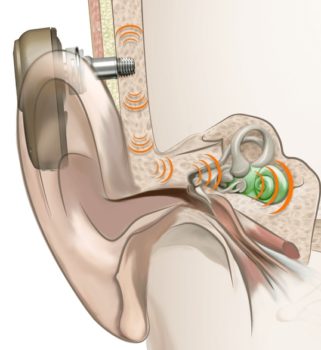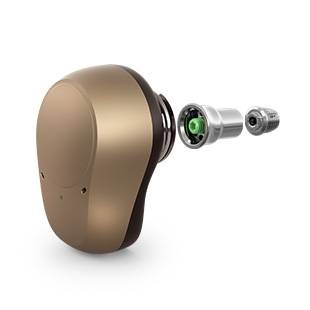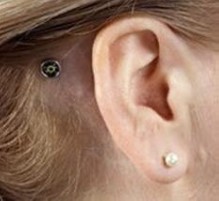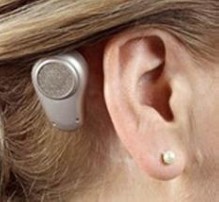On this page
How does a BCHD work?

- Conventional hearing aids send sound down the ear canal, ear drum and middle ear to the cochlea
- BCHDs are a type of hearing aid which are positioned on the bone behind the ear.
- BCHDs send sound directly to the cochlea using vibrations sent through the skull, bypassing the middle ear.
There are three parts to this hearing system:

- Implanted titanium fixture (screw)
- Titanium abutment (like a press stud)
The fixture and abutment together are known as the implant - Sound processor (hearing aid)
Sound processor

The sound processor clips on and off.
The sound processor picks up sound and converts this into vibrations.
These vibrations are transferred to the abutment and fixture and sent into the bones of the skull.

The vibrations pass through the skull to the cochlea which is encased in bone.
The cochlea detects these vibrations (similar to those from the ear drum and ossicles) and converts them into electrical impulses which are sent to the brain to be interpreted as sound.
Who is suitable for a BCHD?
Patients with a conductive hearing loss
- This may be caused by a problem with the ear canal, the middle ear, or both.
- A conventional hearing aid may struggle to overcome these problems and the sound may not be delivered correctly.
- However, a BCHD would bypass this and send the sound directly to the cochlea via the bone surrounding it.
Patients unable to wear a conventional hearing aid
- Reasons may include:
- Very frequent ear infections
- Severe allergies
- Absent or extremely small outer ear or ear canal
- A BCHD is not worn within the ear, therefore, leaving the ear open.
Patients with single sided deafness
- Some patients have useful hearing in only one of their ears and gain no benefit from a hearing aid in their non-hearing ear.
- As they can only hear sound through one ear they struggle in noisy environments and find it difficult to locate sounds.
- A BCHD can be implanted on the poorer hearing side.
- As a BCHD sends vibration of sound through the skull to both ears at the same time, they will be heard in the better ear.
- This allows the patient to detect sounds on the poor side and hear them on the good side.
Frequently asked questions
Everyone referred for a BCHD assessment has many questions. Most people have very little knowledge about BCHDs before they come for an assessment. Here are some of the most common questions. You will be able to ask as many questions as you like during your assessment.
If I come for an assessment, am I committed to having a BCHD?
No. You can withdraw from the process at any time, including after the team have met to discuss your case.
Is there an age limit for BCHDs?
No. We will consider individuals of any age for a BCHD.
What would I hear with a BCHD?
Part of the assessment process is a trial of the BCHD device. The use of the device on the implant can be mimicked by wearing the device on a headband or softband. By placing the device against the skin the vibrations will still be sent through the skin and bone and you will get a rough idea of what the device will sound like when on the implant.
Will a BCHD help me hear in background noise?
Depending on the type of hearing loss you have, a BCHD may help you to hear better in background noise. However, the majority of users still struggle to hear in background noise to some degree.
Would I be able to use the phone with a BCHD?
You can use a phone much in the same way as you do with conventional hearing aids, by holding the receiver over the microphones on the device. There are also accessories available that allow you to stream calls from your mobile phone straight into the device.
Are there different models of BCHD available and do I get a choice?
Yes, there are different models available and you would get to express your preference as to which you prefer. The final decision regarding which model you will receive may be made by the BCHD team.
Does the implant last forever?
Once implanted, the screw will remain in the skull bone unless something happens to cause it to fall out e.g. infection or trauma. The abutment may be removed or changed if necessary.
Does it run on batteries?
Yes. The device needs batteries to work. These are similar to the batteries used for hearing aids.
Can I use a loop system with a BCHD?
A BCHD can be used with existing loop systems.
What happens once I have been referred?
You will attend for a BCHD assessment appointment. You’re suitability will be determined by your medical history, hearing test and assessment of your listening ability. If a trial is appropriate you will be fitted with a trial device to try for approximately 3 weeks. You can then decide following this if you wish to proceed.
What devices do we offer?
We currently offer devices from two companies, Cochlear and Oticon Medical.
I think I might be suitable for a BCHD, what do I do now?
Speak to your local audiology service so that they can arrange an appointment to check your hearing and hearing aids and discuss with you whether a BCHD assessment is the right thing for you.